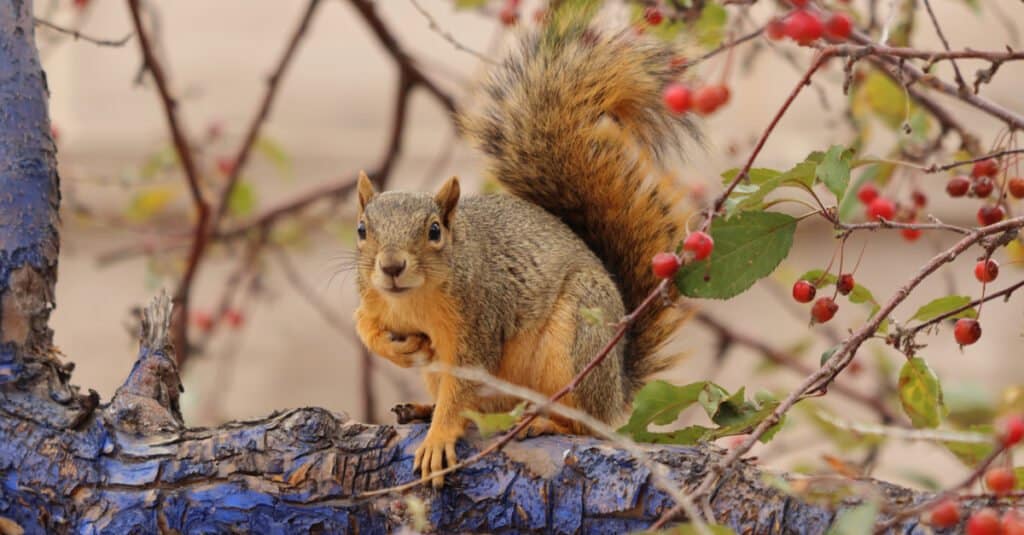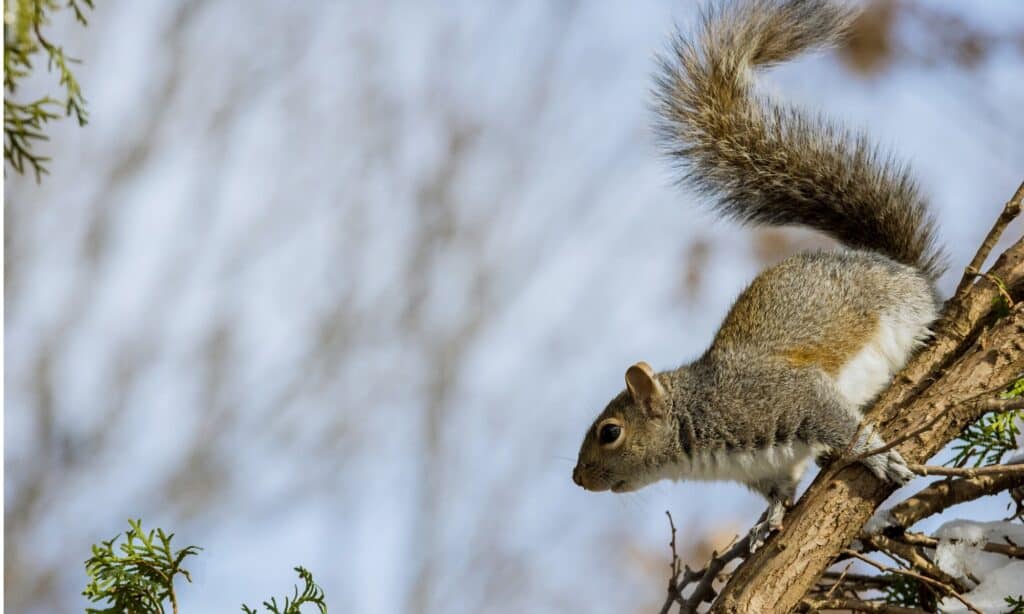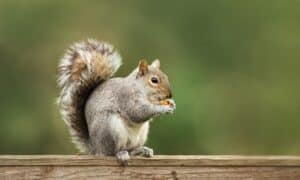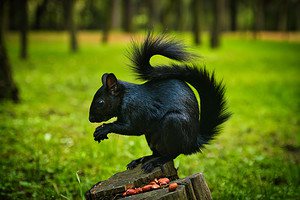As the weather turns cooler in the fall, you may notice enthusiastic squirrels scampering about as they gather up acorns, nuts, and seeds to store for winter. But where do squirrels go in the winter? Well, it depends. You see, there are over 280 different species of squirrels in the world, from flying squirrels to ground squirrels and tree squirrels. All squirrels are warm-blooded, so they need to stay warm, but where do they go? This article will explain where squirrels go in the winter, what they do, and how they survive despite the bitter cold.
Where Do Squirrels Live During the Winter?

During the winter, squirrels may hibernate, enter a state of torpor, or huddle in dens to survive the cold.
©Vaclav Matous/Shutterstock.com
Different types of squirrels use different tactics to survive when it gets cold. Let’s take a closer look at where ground squirrels, tree squirrels, and flying squirrels live during the winter.
1. Hibernating Ground Squirrels
Ground squirrels are the only type of squirrel that hibernates. During hibernation, their body temperature, heart rate, and breathing rate all drop as the squirrels enter a deep sleep to save energy. While hibernating, these squirrels do not eat, drink, or eliminate until they wake up again.
During the fall, ground squirrels dig sloped burrows in the ground where they will hunker down for the winter season. They may also dig burrows under logs or rocks for extra protection. Ground squirrels often hibernate for three months or more at a time. Some occasionally wake up to forage for food. However, some squirrels, like the Richardson’s ground squirrel, can hibernate for up to nine months at a time!
Here are a few examples of ground squirrels that hibernate:
- Rock squirrel (Mexico, southwestern United States)
- California ground squirrel (western United States)
- Washington ground squirrel (Washington and Oregon)
- Merriam’s ground squirrel (Idaho, Nevada, Oregon)
- Arctic ground squirrel (Arctic and subarctic of Asia and North America)
- Richardson’s ground squirrel (Canada, northern United States)
- Long-tailed ground squirrel (China, Mongolia, Kazakhstan, Russia)
- Belding’s ground squirrel (western United States)
- Uinta ground squirrel (Utah)
- Franklin’s ground squirrel (North America)
- Columbian ground squirrel (Canada, United States)
2. Sleeping Tree Squirrels

Tree squirrels do not hibernate, but enter a lethargic state called torpor during the cold winter months.
©iStock.com/photovs
Tree squirrels, on the other hand, do not hibernate. Instead, some species go into a lethargic or lazy-like sleep called “torpor”. During torpor, their heart rate, breathing, body temperature, and metabolism decrease to help them conserve energy, and they may sleep for several days at a time. These squirrels build nests called “dreys” out of twigs and sticks and line them with feathers, leaves, grass, and moss to ward against the cold. Squirrels build their dreys in tall trees or even attics, sheds, and garages.
However, even tree squirrels that do not go into a state of torpor during the winter only go outside to forage, usually in the early mornings or late afternoons, and sometimes they can sleep for 18-20 hours.
Here are some examples of common tree squirrels that you might see occasionally during the winter:
- Fox squirrel (North America)
- Grey squirrel (North America)
- Eurasian Red squirrel (Europe and Asia)
- Red squirrel (North America)
- Douglas squirrel (Pacific Northwest of North America)
- Japanese squirrel (Japan)
3. Snuggling Flying Squirrels
Flying squirrels do not hibernate, and most do not go into torpor. For example, studies show that northern flying squirrels and southern flying squirrels in the United States very rarely go into states of torpor, and even when they do, it is short-lived and very shallow sleep. Instead, flying squirrels build dens in tree trunks and huddle together with other squirrels to stay warm. Northern flying squirrels are much more tolerant of colder temperatures and remain active throughout the winter, only bunkering down on extremely cold days.
Here are a few of the flying squirrels you might see out and about on warmer winter days:
- Southern flying squirrel (North America)
- Northern flying squirrel (North America)
- Humboldt’s flying squirrel (North America)
How Do Squirrels Prepare for Winter?

To prepare for winter weather squirrels build up a food cache that will last through times of scarcity.
©Vik93/Shutterstock.com
Most squirrels are extra active in the fall as they prepare for the winter cold. During this time, you may see them scurrying around and collecting food. Squirrels are mainly herbivores and eat all kinds of seeds, nuts, berries, fungi, and plants. During the fall, however, they focus primarily on gathering acorns and nuts. They save much of this food for later, hiding it in holes and under rocks and logs.
This process of hoarding food for winter is called “caching”, and a single squirrel can gather enough food to last them for up to 3 years! Female squirrels in particular require a lot of food during the winter since they often give birth in February or March.
Throughout the winter, squirrels return to their hidden cache spots to retrieve their food stashes. However, as squirrels have countless caches, they generally do not remember all their hiding spots. However, the seeds and fruit in forgotten caches often end up germinating into new plants in the spring.
In addition to caching, squirrels aggressively eat a lot during the fall to help increase their body mass and fat storage. The extra layers of fat help to insulate their small bodies and keep them warm throughout the cold winter months. This is referred to as “layering.”
Squirrels also grow a thicker fur coat for the winter that is often a different color from their summer coat to help them blend in with the snow. This new fur is much denser and provides another protective layer of insulation to keep the cold out.
How Do Squirrels Survive the Cold During Winter?
But what do squirrels do during the winter months? In addition to their dense fur coats and layers of fat storage, squirrels have a few more tricks that help them to stay warm against the winter cold.
Even squirrels that do not hibernate or go into torpor rarely go outside during winter. Instead, they cohabitate together with other squirrels and spend most of their time huddled up in their dreys, snuggling together to stay warm.
When they do venture out into the cold, it is usually on warmer winter days, and they move very quickly to keep their body temperature up. If you do happen to see a squirrel running around during the winter, it is likely either a tree squirrel or a flying squirrel, since ground squirrels hibernate.
Squirrels also shiver, but not in the way you might think. While humans shiver because we are cold, squirrels shiver to keep out the cold! Shivering helps squirrels to generate more heat in their small bodies, which helps them to stay warm against the cold winter temperatures.
So, despite not migrating to warmer climates during the winter, squirrels survive the cold using these unique techniques:
- Caching
- Layering
- Thicker fur coat
- Conserving energy
- Staying inside
- Cohabitating
- Shivering
Up Next:
- 10 Incredible Squirrel Facts
- How and Where Do Squirrels Sleep? Everything You Need to Know.
- Do Skunks Hibernate in the Winter?
- Top 10 Animals that Hibernate (Excluding Bears)
The photo featured at the top of this post is © Christine Bird/Shutterstock.com
Sources
- National Library of Medicine, Available here: https://pubmed.ncbi.nlm.nih.gov/29108557/
- Physiological and Biochemical Zoology, Available here: https://www.journals.uchicago.edu/doi/abs/10.1086/physzool.62.6.30156213
Thank you for reading! Have some feedback for us? Contact the AZ Animals editorial team.






